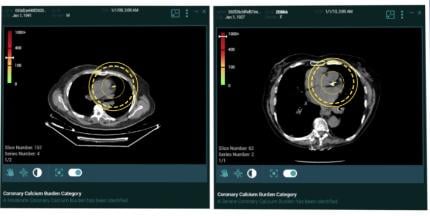
September 27, 2021 — Zebra Medical Vision, the deep-learning medical imaging analytics company, announces its eighth U.S. FDA 510(k) clearance for its cardiac solution HealthCCSng, which enables the quantification of the coronary artery calcium (CAC) on CT scans as an incidental finding. The solution already received European CE mark.
The CAC solution will allow clinicians to report findings and recommend preventative treatments before a coronary event occurs, subsequently saving lives while lowering costs for the healthcare systems.
Approximately 90% of the annual $3.5 Trillion healthcare spending is allocated towards chronic disease management. Cardiovascular disease (CVD) leads all chronic diseases with the highest mortality in the world, with many cases discovered far too late. Up to 50 percent of patients discover they suffer from CVD only with their first heart attack. CAC scoring is the strongest predictor of future cardiac events, with patients in the highest score category being over 20 times more likely to suffer a cardiac event. Moreover, many studies show clear correlation between coronary artery calcium detected and severity of disease. Typically, CAC scoring may be attained on a cardiac-gated scan which subjects patients to additional cost and radiation exposure, and is typically not covered by insurance companies.
The HealthCCSng solution developed by Zebra-Med analyzes commonly ordered non-gated CT scans, which enables the quantification of the Coronary Artery Calcium (CAC) as an incidental finding and categorizes the patients into three categories, based on extent of cardiac calcium detected. The solution supports clinicians in diagnosing patients with CVD who were previously undetected, while stratifying such patients so that they can get the appropriate preventative cardiac care and treatment. By implementing the FDA-cleared HealthCCSng, IDNs and commercial payers can actively manage and stratify their covered population health risk, while significantly reducing cost of care through early intervention. As a result, patients can be placed on relevant care pathways to prevent or mitigate the chance of a future incident by detecting early signs of disease and estimating the likelihood of future cardiovascular events.
"This new milestone shows the FDA’s trust in our work, enabling broader adoption of imaging AI as an integral part of value-based care," said Zohar Elhanani, CEO of Zebra Medical Vision. "Zebra-Med’s population health solutions have already demonstrated great value in identifying patients at risk for major osteoporotic fractures. The company remains firmly committed to its robust product roadmap, which is designed to advance population health and preventative care."
Last month Zebra-Med announced it has entered into an agreement to be acquired by Nanox, a medical imaging company. This agreement, once consummated, puts Zebra-Med on track to expand its mission of helping to diagnose populations at scale with its AI-based solutions, enabling IDNs and commercial payers to detect and treat patients at risk for chronic conditions while accurately adjusting their covered population risk.
"I believe that our expected collaboration with Nanox, and the implementation of our AI solutions with Nanox’s technology can help impact millions of lives globally, while significantly reducing cost of care," Elhanani said.
For more information: www.zebra-med.com, www.nanox.vision
Related CT Calcium Scorining Content:
VIDEO: The History of CT Calcium Scoring — Interview with Arthur Agatston, M.D.
VIDEO: New Cholesterol Guidelines Support CT Calcium Scoring for Risk Assessment — Interview with Matthew Budoff, M.D.
CT Calcium Scoring Becoming a Key Risk Factor Assessment
ACC and AHA Release Updated Cholesterol Guidelines for 2018
VIDEO: CT Calcium Scoring to Screen For Who Should Take Statins — Interview with Matthew Budoff, M.D.
VIDEO: Overview of CT Calcium Scoring Cardiac Risk Assessment for Patients
VIDEO: Example of an Automated CT Cardiac Calcium Scoring Exam


 May 16, 2024
May 16, 2024 








